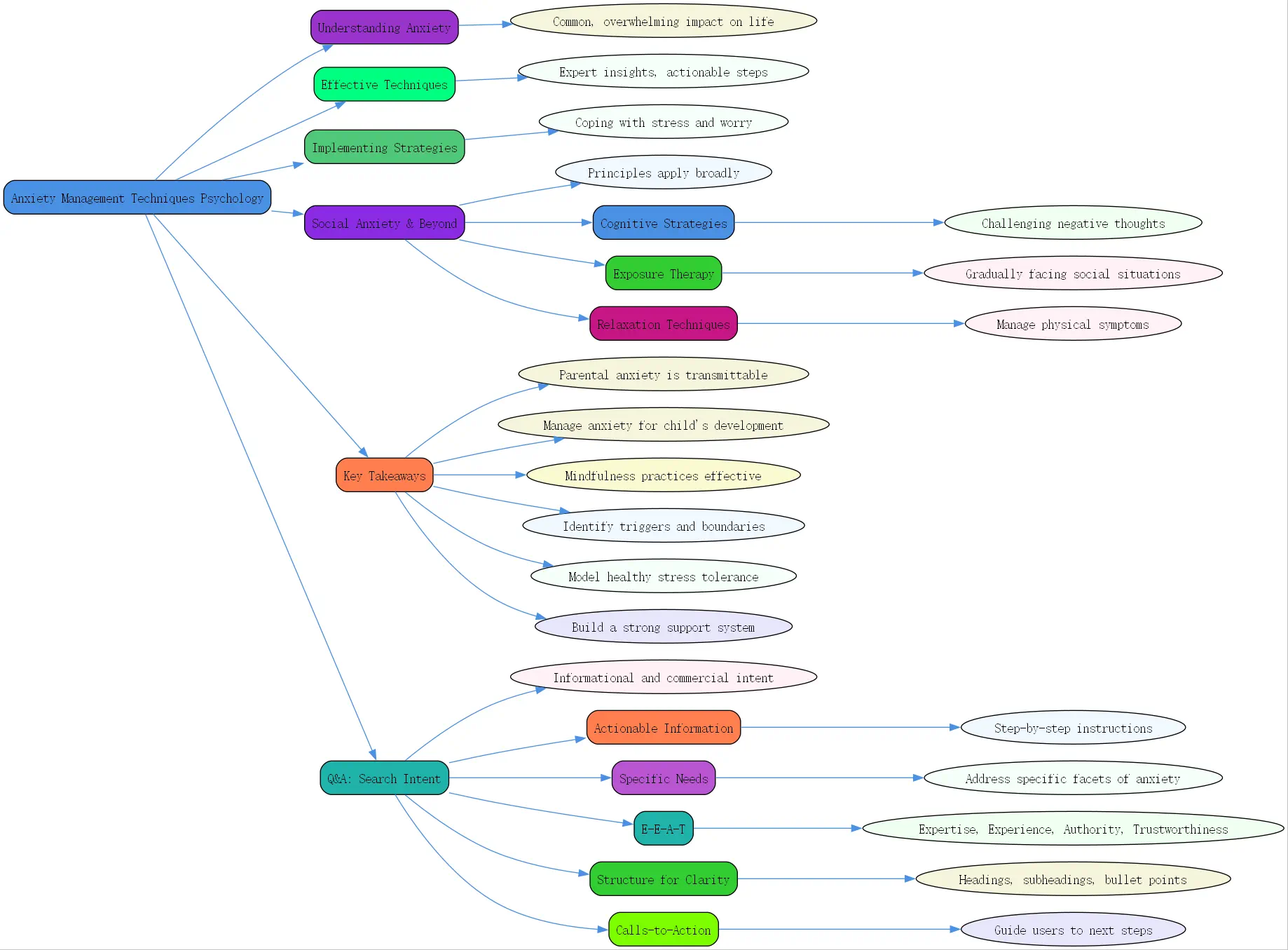Anxiety Management Techniques Psychology: A Comprehensive Guide

Anxiety is a common human experience, but when it becomes persistent and overwhelming, it can significantly impact daily life. Understanding the roots of anxiety and learning effective management strategies is crucial for both personal well-being and for fostering a calmer environment for those around us, especially children. This guide explores anxiety management techniques psychology offers, drawing on expert insights to provide actionable steps for coping with stress and worry.
Understanding Anxiety and Its Impact
Anxiety doesn’t exist in a vacuum. For parents, their own anxiety can inadvertently shape their child’s emotional landscape. Recognizing this connection is the first step toward breaking potentially negative cycles and building resilience in both yourself and your children. It involves understanding how anxiety can be transmitted and why managing your own stress is paramount.
- How Parental Anxiety Affects Children: The Cycle of Learned Behavior
Witnessing a parent frequently in distress can be deeply unsettling for a child. Kids naturally look to their caregivers to understand how to react to new or uncertain situations. If a parent consistently displays anxiety or fear, a child may learn to perceive a wide range of scenarios as inherently unsafe, internalizing that anxious response. This learned behavior can significantly shape their developing worldview.
This doesn’t mean anxious parents are intentionally harming their children; it’s often an unconscious transmission. Children are highly perceptive, like little sponges, absorbing emotional cues. A parent’s chronic worry sends signals that the world is dangerous, prompting the child to adopt similar patterns of thinking and feeling as a way to navigate perceived threats.
- The Role of Genetics vs. Learned Behaviors in Child Anxiety
Research suggests that children of anxious parents are indeed more likely to develop anxiety themselves. This increased vulnerability is likely a complex interplay between genetic predispositions and learned environmental factors. While a child might inherit a biological tendency towards anxiety, observing and mimicking an anxious parent’s coping mechanisms (or lack thereof) strongly reinforces these tendencies.
Understanding this combination is vital. It highlights that while genetic factors play a role, learned behaviors are modifiable. This empowers parents by showing that their actions and coping strategies can significantly influence their child’s developmental trajectory regarding anxiety, offering hope for positive change.
- Why Addressing Your Own Anxiety is Crucial for Your Child’s Well-being
The realization that your anxiety might be affecting your child can evoke feelings of guilt. However, getting bogged down by self-blame is counterproductive. Anxiety is challenging to live with and not easily switched off. The most constructive approach is to acknowledge the potential impact and proactively implement strategies to manage your own stress effectively.
By managing your anxiety, you not only improve your own quality of life but also model healthier coping mechanisms for your child. This dual benefit is often a core part of family-focused anxiety treatment. Helping parents manage their stress provides them with the tools and emotional bandwidth needed to support their anxious child more effectively, creating a more supportive home environment.

Effective Anxiety Management Techniques
Fortunately, psychology offers a wealth of evidence-based techniques to manage anxiety. These strategies focus on calming the nervous system, changing thought patterns, and building resilience to stress. Incorporating these into your life can make a profound difference. Here, we explore practical anxiety stress management techniques.
- Mindfulness and Relaxation Strategies for Anxiety Stress Management Techniques
Feeling anxious often involves worrying about future “”what ifs.”” Mindfulness pulls your focus back to the present moment, interrupting the cycle of worry. Relaxation techniques directly counteract the body’s physical stress response. Practicing these regularly builds your capacity to stay calm under pressure.
* Progressive Muscle Relaxation (PMR): A Step-by-Step Guide PMR involves systematically tensing and then releasing different muscle groups. Start with your toes: squeeze the muscles tightly for about five seconds, then release, noticing the feeling of relaxation. Gradually work your way up your body 閳?feet, calves, thighs, abdomen, chest, arms, hands, neck, and face 閳?tensing and releasing each group. This process highlights the contrast between tension and relaxation, enhancing body awareness.
* Belly Breathing: How to Calm Your Nerves Also known as diaphragmatic breathing, this technique encourages deep, calming breaths. Place one hand on your chest and the other on your belly. Inhale slowly and deeply through your nose, feeling your belly expand like a balloon while keeping your chest relatively still. Exhale slowly through your mouth, feeling your belly gently deflate. Repeat this several times, focusing on the rhythm of your breath.
* Incorporating Mindfulness into Daily Life: Regular Practice While these techniques are powerful tools in moments of acute anxiety, their real benefit comes from consistent practice. Set aside even just five to ten minutes each day for mindfulness or relaxation exercises. This regular practice trains your brain and body to access a state of calm more readily, making the techniques more effective when you truly need them during stressful moments. It also contributes to a lower baseline level of anxiety over time.
- Identifying and Managing Anxiety Triggers
While anxiety can sometimes feel random, it often has specific triggers 閳?situations, thoughts, or even physical sensations that set off the worry cycle. Recognizing your personal triggers is a key step in regaining control. Once identified, you can develop strategies to manage your exposure or reaction to them.
Recognizing Personal Anxiety Triggers Pay close attention to when and where your anxiety spikes. Keep a journal for a week or two, noting situations, thoughts, or physical feelings that precede anxious episodes. Are you more anxious after reading the news? Before social events? When facing uncertainty at work? Identifying these patterns helps you anticipate and prepare for potential challenges. Understanding what* sparks your anxiety is crucial.
* Setting Boundaries with Triggering Content (e.g., News, Social Media) Constant exposure to distressing news or the curated perfection of social media can significantly exacerbate anxiety. If you notice these are triggers, set firm boundaries. Limit your news intake to specific times or trusted sources. Consider reducing social media use or unfollowing accounts that make you feel worse. Protecting your mental space from unnecessary triggers is a vital act of self-care.
* When to Seek Professional Help: Consulting a Mental Health Professional If your anxiety feels severe, persistent, or significantly interferes with your daily life despite self-help efforts, seeking professional support is essential. A therapist or counselor can provide a diagnosis, help you understand the roots of your anxiety, and teach you personalized anxiety management techniques psychology has validated through research. They offer tailored strategies, such as Cognitive Behavioral Therapy (CBT) or Acceptance and Commitment Therapy (ACT), suited to your specific needs.
- Modeling Stress Tolerance: Teaching Children Coping Mechanisms
As you learn and practice anxiety management strategies, you gain a valuable skill set 閳?one you can pass on to your children. Since children learn by observing, how you handle stress powerfully influences how they learn to cope. Modeling resilience, even amidst your own struggles, is a profound gift.
* Communicating Rationally During Stressful Times When you feel anxious, try to verbalize a rational perspective, both for yourself and, when appropriate, for your child. If your child expresses fear, validate their feeling (“”I understand you’re feeling scared””) but gently challenge the likelihood of the feared outcome (“”What do you think the real chances are that something scary will happen?””). This models reality-testing, a key cognitive skill for managing anxiety.
* Being Mindful of Your Demeanor: Facial Expressions, Words, and Emotions Children are incredibly attuned to non-verbal cues. Even if you’re trying to stay calm, anxious facial expressions, a tense tone of voice, or agitated body language can signal danger to a child. Be mindful of how you present yourself during stressful moments. Aim for a calm, neutral demeanor as much as possible, even while acknowledging the difficulty of the situation. Your perceived calm can be incredibly reassuring.
* Explaining Your Anxiety: Open Communication with Your Child You don’t need to hide every instance of stress from your children. Shielding them completely can inadvertently send the message that negative emotions are unacceptable or unmanageable. It’s healthy for children to see parents cope with stress occasionally. The key is to explain your reaction afterward in an age-appropriate way.
For instance, if you reacted irritably because you were stressed about being late, you could later say, “”Remember when I got frustrated this morning? I was feeling worried about being late. Yelling wasn’t the best way to handle my worry. Maybe we can think of a better way to manage mornings together.”” This approach normalizes feeling stressed, demonstrates accountability, and shows that anxiety is something that can be actively managed. It gives children permission to feel and express their own difficult emotions.
Practical Strategies for Implementing Anxiety Management Techniques
Knowing the techniques is one thing; putting them into practice effectively, especially within the complexities of family life, is another. This requires planning, structure, and support. Thinking strategically about implementation can make these techniques more accessible and sustainable.

- Creating a Plan: Anxiety Management Techniques Occupational Therapy
Developing proactive plans for managing known stressors can significantly reduce anxiety’s impact. This structured approach aligns well with principles often used in anxiety management techniques occupational therapy, which focuses on practical strategies and environmental modifications to support daily functioning and well-being. Creating routines and predictable responses can provide a sense of control.
Developing Strategies for Specific Stressful Situations Identify recurring situations that trigger your anxiety (e.g., bedtime routines, school mornings, crowded places). Brainstorm specific coping strategies you can deploy before or during* these events. This might involve practicing belly breathing before entering the situation, having a calming mantra ready, or structuring the activity differently. Having a pre-defined plan reduces the mental load in the moment.
Involving Your Child in the Planning Process For family-related stressors, involve your child in creating solutions when appropriate. If mornings are chaotic, sit down together during a calm time and brainstorm ways to make them smoother. Perhaps creating a visual checklist or setting out clothes the night before could help. This collaborative approach empowers the child and fosters teamwork, but remember to use these strategies sparingly 閳?the responsibility for managing your* anxiety should not fall on your child.
* Knowing When to Disengage: Removing Yourself from Overwhelming Situations Sometimes, the most effective strategy is to temporarily remove yourself from a situation that is becoming overwhelmingly stressful, especially when in the presence of your child. If you feel yourself escalating, it’s okay to take a brief break to regulate yourself. This prevents you from modeling extreme distress and gives you space to use your coping techniques.
For instance, if school drop-offs are acutely anxiety-provoking for you while you’re working through it in therapy, arranging for a co-parent or another trusted adult to handle them temporarily might be wise. This prevents your child from interpreting your anxiety as a sign that school separation is inherently dangerous. The goal isn’t permanent avoidance but strategic disengagement while you build coping capacity.
- Building a Support System: Finding Help and Understanding
Parenting while managing your own mental health challenges can feel isolating. You don’t have to navigate this alone. Building a robust support system is not a sign of weakness but a crucial component of resilience and effective anxiety management. Support can come in many forms.
* Leveraging Online Resources: Blogs, Forums, and Social Media The digital world offers a wealth of information and connection. Reputable mental health organizations (like the Child Mind Institute or NIMH [External Link: NIMH]), expert blogs (such as those found on platforms like BrainTalking), and moderated online forums can provide valuable insights, coping strategies, and a sense of community with others facing similar challenges. Be mindful of sourcing credible information.
* Seeking Support from Therapists, Co-Parents, and Friends Your real-world network is invaluable. Therapists provide professional guidance. Your co-parent can be a crucial ally in implementing consistent strategies. Friends and trusted family members can offer emotional support, a listening ear, or practical help when you feel overwhelmed. Don’t hesitate to lean on those who care about you and communicate your needs.
Social Anxiety Management Techniques and Beyond
While this guide focuses heavily on managing general anxiety, particularly in the context of parenting, many of these principles apply broadly. For instance, social anxiety management techniques often involve similar cognitive strategies (challenging negative thoughts about social evaluation), exposure therapy (gradually facing feared social situations), and relaxation techniques to manage physical symptoms during social interactions. Identifying triggers (like large gatherings or public speaking) and developing specific coping plans are also key.
The core message remains consistent across different anxiety presentations: understanding your anxiety, learning effective coping mechanisms derived from anxiety management techniques psychology, practicing consistently, modeling healthy responses, and building a strong support system are fundamental steps toward living a calmer, more fulfilling life. For more specific strategies tailored to social anxiety or other anxiety disorders, consider consulting resources focused on those conditions [Internal Link: Social Anxiety Resources] or speaking with a mental health professional.

- Parental anxiety can be transmitted to children through learned behaviors, but this cycle is not inevitable.
- Managing your own anxiety is crucial for both your well-being and your child’s emotional development.
- Mindfulness practices like Progressive Muscle Relaxation and Belly Breathing are effective anxiety stress management techniques.
- Identifying personal anxiety triggers and setting boundaries is vital for regaining control.
- Modeling healthy stress tolerance and openly communicating about anxiety (appropriately) teaches children valuable coping skills.
- Developing proactive plans for stressful situations, sometimes drawing on anxiety management techniques occupational therapy principles, can reduce anxiety’s impact.
- Building a strong support system, including professional help when needed, is essential.
- Techniques for general anxiety often overlap with strategies for specific types, like social anxiety management techniques.
Q&A: Understanding Search Intent for Anxiety Content
Q: How can I ensure my content about anxiety management truly meets what users are searching for (search intent)?
A: Understanding search intent for anxiety-related queries is crucial for creating genuinely helpful and findable content. Users searching for “”anxiety management techniques psychology”” likely have informational and commercial investigation intent. They want to learn what techniques exist (informational) and potentially find which ones are most effective or where to get help (commercial investigation, leading towards therapy or resources).
To meet this intent: 1. Provide Actionable Information: Don’t just define anxiety; offer clear, step-by-step instructions for techniques like PMR or belly breathing. Explain the why behind them (psychological basis). 2. Address Specific Needs: Incorporate long-tail keywords like “”anxiety stress management techniques”” or “”social anxiety management techniques”” to address specific facets of anxiety, showing comprehensive coverage. Mentioning approaches like those used in occupational therapy signals practical, structured solutions. 3. Establish E-E-A-T: Demonstrate expertise (citing psychology principles), experience (empathetic, practical tone), authority (referencing experts or established methods like CBT), and trustworthiness (suggesting professional help when needed, linking to reputable sources [External Link: Authoritative Source]). As BrainTalking, leveraging our psychological expertise is key. 4. Structure for Clarity: Use headings, subheadings, and bullet points (like in this article) to make complex information digestible. Users seeking anxiety relief need easily scannable and understandable content. 5. Include Calls-to-Action (Implicit/Explicit): Guide users toward next steps, whether it’s trying a technique, reading related articles [Internal Link: Related Content], or seeking professional consultation.




